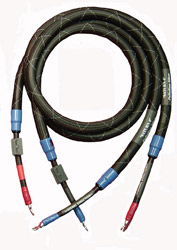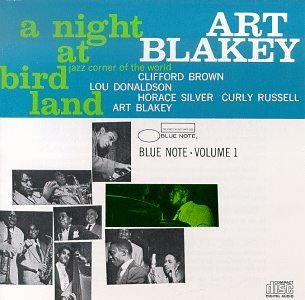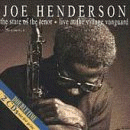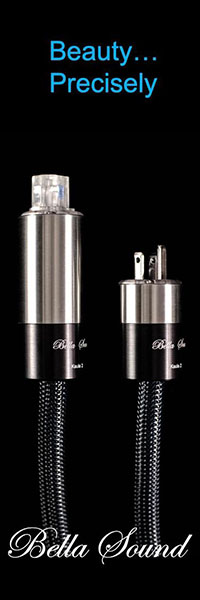ELCO AUDIO Blue Star Cables
| ELCO AUDIO Blue Star Cables |
| Stars Indeed |
|
|
|
May 2006 |
Discovering ELCO Audio Cables
 My appreciation for the ever-increasing audiophile cable market is growing and growing. To be certain, we have designers and manufacturers coming up with new ideas, new lines of equipment and new ways to improve on something already in existence. It’s the cable market that seems to have the most new entrants. I use the word “new” loosely because when you speak to these guys, most have been around for a while but never had the budget or the time and energy to get out in the marketplace or bring their ideas to fruition. With the advent of the Internet, these guys have a chance to be seen and heard. Trust me when I say that most of these guys are pretty sharp and know just about as much as a lot of the big name manufacturers do, just without a lot of magazine exposure big advertising budgets. One such company is ELCO Audio. After receiving marching orders from Clement Perry to, “check these guys out,” a little research bought me to their well thought out and informative website. But I still wanted to find out more and tried to glean what little information I could find about ELCO from a few of the on-line audiophile “hotspots”, but still could not find out much. An acquaintance at one of the local audio shops mentioned that he’d heard of ELCO but didn’t know much else about them. So after a few emails went back and forth, I finally found the information I was searching for and got in contact with ELCO’s Andrew Schnaider.
My appreciation for the ever-increasing audiophile cable market is growing and growing. To be certain, we have designers and manufacturers coming up with new ideas, new lines of equipment and new ways to improve on something already in existence. It’s the cable market that seems to have the most new entrants. I use the word “new” loosely because when you speak to these guys, most have been around for a while but never had the budget or the time and energy to get out in the marketplace or bring their ideas to fruition. With the advent of the Internet, these guys have a chance to be seen and heard. Trust me when I say that most of these guys are pretty sharp and know just about as much as a lot of the big name manufacturers do, just without a lot of magazine exposure big advertising budgets. One such company is ELCO Audio. After receiving marching orders from Clement Perry to, “check these guys out,” a little research bought me to their well thought out and informative website. But I still wanted to find out more and tried to glean what little information I could find about ELCO from a few of the on-line audiophile “hotspots”, but still could not find out much. An acquaintance at one of the local audio shops mentioned that he’d heard of ELCO but didn’t know much else about them. So after a few emails went back and forth, I finally found the information I was searching for and got in contact with ELCO’s Andrew Schnaider.
Meeting Mr. ELCO Audio
Andrew Schnaider is the man behind ELCO Audio and is its owner and president. In the 5 years that ELCO Audio has been in existence, it has grown and now conducts business in Canada, Europe, Asia, South Korea and Australia. Andrew is a very sharp individual and has some very keen and thought-provoking ideas about cables. Andrew’s background is 25 years in electronic engineering with a lot of time spent in the RF and microwave cable manufacturing industry. From there, he decided to bring his experience and knowledge to the field of audio cable design. It is Andrew’s opinion that many of audio cable designers are trying to reach a level of performance parameters by ‘blindly” listening to their final product and getting a quality evaluation that is based on their hearing ability only. This testing procedure leads to getting a subjective opinion and could not be considered as being totally accurate.
At ELCO Audio, they work on creating an impartial and objective method for testing audio cables. “It is well known that the frequency ranges for a microwave field are a hundred thousand times higher than audio frequency ones,” said Andrew. “This in turn stipulates a different physical process of electrical signal propagation via high frequency and audio range transmitting lines (cables). Design of high frequency lines requires a lot of attention on such important physical phenomena as phase distortion, harmonic distortion, velocity of propagation, return loss, reflections, mechanical and electrical resonances, etc., interaction all of these and their affectation on the final signal transmitting quality. These physical phenomena are not apparently evinces within audio frequency range, but could not be neglected by designer.” He continues, “Use of RF and microwave physical principals in high end audio cable design is very helpful for understanding the physical process of audio signal non distorted transmitting. Carefully mathematically calculated inner conductor geometry together with very expensive high purity (99.9996%) materials such as gold, silver, rhodium and palladium makes ELCO Audio cable design not surpassed on today’s audio market. These are not just ‘exotic’ materials but the total combination of such important parameters as specific conductivity, plating thickness and quality, inner geometry, conductor homogeneity and diameter’s ratio and the other proprietary technical parameters that makes this a very serious task of making the ‘ideal’ cable feasible.”
That’s all well and good but if the cables don’t sound good, then we’re left with a lot of rhetoric and a lot of cables that no one’s buying. Let’s take a look at Andrew’s ideas put into action.
How do ELCO Audio cables sound?
The ELCO Audio cables are not only well made and attractive, but they sound excellent. Across the board, the ELCO cables are tonally neutral. They allow for an abundance of detail and information about the recording to pass through and allow components to perform with an increased level of focus and musical involvement.
Let me start with the power cords. The ELCO Blue Star Digital Power Cord has the relative thickness of larger cables, such as power cords from Sunny Cable Technology and DCCA Audio. Having broken an IEC connector on a CD player using an older DCCA Audio Extreme Reference power cord, my first thought when I received the ELCO power cords was “Oh no, here we go again”. When I took hold of the power cords, they were very light and flexible, which put a very big grin on my face. The Blue Star allowed the CD players I had on hand to convey a more natural sound to the music. By this I mean instrumental and vocal timbers sounded more “lifelike” and less digitized. No, it did not make discs that already sounded hard or cold sound better, but it did make them easier to listen to. Discs that were well recorded, on the other hand, had a naturalness that I found to be pleasant. Moving on to the ELCO Power Amplifier power cord on the amplifier, things began to get interesting. Once this power cord was placed on the amplifiers I used during this review, there was a clear level of improvement over the ones that I normally use. The first improvement that I noticed was that the ELCO power cord seemingly allowed amplifiers to perform better with music emanating from a quieter, darker background. Increases could be heard in the reproduction of ambient information, bloom around instruments, dynamic ranges and low frequency weight and impact. The increases in performance were not subtle, as I was easily able to tell each time the ELCO cord was in the system.
The ELCO Saturn 4 speaker cables are a very good performer as well. With the Saturn 4 in the system, the panels on my Martin-Logans seemed to open up more than with my reference Sunny Cable speaker cable with a smoother top end and a slightly more detailed midrange. Performers tended to have more presence and seemed a bit more fleshed out. The upper frequency performance on my Almarro M2As remained extended and revealing but now had an ease and naturalness to the music that it did not possess when used with the Sunny speaker cables. But my favorite cable from ELCO Audio, by far, has got to be their Blue Star interconnects. This cable was an outstanding performer in my system and one of the very best cables I’ve had the privilege of using. To put it simply, when I had it on any “source” component, that piece’s performance increased by a noticeable margin. My Thor TA-3000 phono preamp never sounded better than when the Blue Star interconnect carried signal between it and the Thor linestage. I could easily hear how more detail, dynamics, tonal colors, chord structure, and musical information, all came through in abundance with both digital and analog front ends. The same was true for each of the digital front ends I used for this review.  The increases in the amount of information extracted from discs and sent to the preamplifier were easily identifiable. On Art Blakey’s A Night at Bird Land [Blue Note BST81521], Clifford Brown’s wonderful trumpet can be heard clearly in the recesses of the vaunted night club as well as a wealth of audience sound, which come through with startling clarity with the Blue Star interconnect in place.
The increases in the amount of information extracted from discs and sent to the preamplifier were easily identifiable. On Art Blakey’s A Night at Bird Land [Blue Note BST81521], Clifford Brown’s wonderful trumpet can be heard clearly in the recesses of the vaunted night club as well as a wealth of audience sound, which come through with startling clarity with the Blue Star interconnect in place.  Likewise, a wealth of tonal color and instrumental timbre was revealed in Joe Henderson’s tenor saxophone artistry from his The State of the Tenor; Live at the Village Vanguard [Blue Note BT 81523]. Herbert Von Karajan directing the Berliner Philharmonic Orchestra in Anton Bruckner’sSymphony No.4 in E flat major ‘Romantic’ is one of my favorite pieces. For some strange reason it make me feel as though I’m flying through the sky on a cool, gray day over England. Don’t ask why. The ELCO cable revealed a layer of detail on the string section of this work, especially on the opening movement, that I had not really noticed before and found to be captivating.
Likewise, a wealth of tonal color and instrumental timbre was revealed in Joe Henderson’s tenor saxophone artistry from his The State of the Tenor; Live at the Village Vanguard [Blue Note BT 81523]. Herbert Von Karajan directing the Berliner Philharmonic Orchestra in Anton Bruckner’sSymphony No.4 in E flat major ‘Romantic’ is one of my favorite pieces. For some strange reason it make me feel as though I’m flying through the sky on a cool, gray day over England. Don’t ask why. The ELCO cable revealed a layer of detail on the string section of this work, especially on the opening movement, that I had not really noticed before and found to be captivating.
Winding it up
Not being a cable manufacturer, I can’t comment on what justifies the prices of cables that reach a certain dollar amount. From what I can tell, there seems to be more sophisticated use of metals with the ELCO cables such as their use of Palladium, along with complex construction techniques. But what I can tell you is that they performed beyond the norm in my system.
The ELCO Audio Blue Star Digital Power Cord, at $2350, is a very good performer and if you don’t have a power cord for your digital source, I can easily recommend this one for you to try in your system. The Blue Star power Cord is also a very good performer and at its $2650 price point, was an audibly better power cord, when used on power amplifiers, than my reference Sunny Cable power cords. Just for the sake of the review, I did try the ELCO Power Amp power cord on my Cary 306/200 and the Esoteric UX-3 CD players, as well as on my Thor TA-1000 preamplifier, but did not have the same kind of dramatic improvement as was rendered when connected to amplifiers.
The ELCO’s Saturn 4 speaker cable was a definite improvement over my reference but affordable 600 series of Sunny cables, having a smoother portrayal of the musical event with better delineated upper frequency information.
Caveats
Unfortunately, I cannot comment on the ELCO cables as a complete system as I could not get a bi-wired set of the Saturn 4s or ELCO’s Palladium/Silver jumpers to use on the woofer sections of my Martin-Logan Quests or Almarro M2As, as this is the optimal configuration to drive both of these speakers full-range. Instead, I used some homemade jumpers with a single-wire set of Saturn 4s but still got very good results. But in all fairness, this is not the best way to evaluate this cable. My comments on the speaker cables are purely directed at the midrange to upper frequency reproduction capabilities of this cable, which are quite good.
The ELCO Audio Blue Star interconnect was by far my favorite of the ELCO cables as it proved itself to be an excellent product over and over again. No other cable I had on hand or had ever borrowed gave me as much satisfaction as these cables did. Without question, I can say that the improvement this cable made in, not only my system, but in friends systems as well, was very impressive. I also can say that when used in systems containing the highest quality (expensive) preamps and amplifiers, such as from Thor Audio or TIDAL Audio, you could understand better why those electronics are priced the way they are.
In some weird way, and because I can’t believe I’m saying this, that “yes” it is worth the cost because of the level of improvement it gave. Let me share two “for instances” with you. I have on hand right now about seven different interconnects. Some are mine, some I borrowed and some I’m working on reviews for. The price range for these cables is anywhere from $300 – $2500. In each and every instance, where I substituted a cable for the ELCO Blue Star interconnect, there was always an improvement in clarity and musicality. I had several friends over for a listening session one night and we could easily tell when the Blue Star was in or out of the system. The other instance of note came from doing my review on the TIDAL Impact and Preos. This $50,000+ combination benefited the most from the ELCO cables being in place, so much so, that I thought they were made for each other. These cables took this wonderful amp and preamp’s performance to a level that made me believe it was possible for electronics to justifiably cost this much money. Is the ELCO Audio Blue Star line of cables expensive? Sure they are. But they also allow your equipment to perform at a level you may not have thought they were capable of. These cables are most highly recommended.
Michael Wright
_____________
ELCO Audio Cables
ELCO Audio Blue Star Interconnect 1 meter pair – $2,295
ELCO Audio Saturn 4 Speaker Cables 6 foot pair – $1,650
ELCO Audio Blue Star Power Amp Power Cord/ 6 foot – $2,650
ELCO Audio Blue Star Digital Power Cord/ 6 foot – $2,350
Company Information
ELCO AUDIO, Inc.
512 Woodglen Rd
Lansdowne, PA 19050
phone: 610/622-1926
fax: 610/622-0111
Website: http://www.elcoaudio.com/cable.php
e-mail sigma@elcoaudio.com
![]()
Don’t forget to bookmark us! (CTRL-SHFT-D)
Stereo Times Masthead
Publisher/Founder
Clement Perry
Editor
Dave Thomas
Senior Editors
Frank Alles, Mike Girardi, Russell Lichter, Terry London, Moreno Mitchell, Paul Szabady, Bill Wells, Mike Wright, and Stephen Yan,
Current Contributors
David Abramson, Tim Barrall, Dave Allison, Ron Cook, Lewis Dardick, John Hoffman, Dan Secula, Don Shaulis, Greg Simmons, Eric Teh, Greg Voth, Richard Willie, Ed Van Winkle, Rob Dockery, Richard Doran, and Daveed Turek
Site Management Clement Perry
Ad Designer: Martin Perry





Be the first to comment on: ELCO AUDIO Blue Star Cables